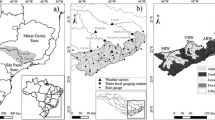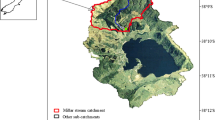Abstract
After the SWAT (Soil and Water Assessment Tool) model was calibrated and validated to historic flow records for the current land use conditions, two additional land cover scenarios (a prehistoric land cover and a potential maximum plantation pine cover) were used to evaluate the impacts of land cover change on total water yields, groundwater flow, and quick flow in the Motueka River catchment, New Zealand. Low-flow characteristics and their potential impacts on availability for water abstraction and for support of in-stream habitat values were focused on. The results showed that the annual total water yields, quick flow and baseflow decreased moderately in the two scenarios when compared with the current actual land use. The annual water balance for the pine potential land cover scenario did not differ substantially from the prehistoric scenario for the catchment as whole. However, there were more notable differences among individual tributary catchments, which could be attributed to the relative area of land cover altered and location of those catchments. Simulated low flows for the prehistoric and potential pine land cover scenarios were both significantly lower than the low flows for the current land use. In summary, under the current land use conditions, both annual water yield and low flow are higher than was the case before human intervention in the area or in a maximum commercial reforestation scenario.
Similar content being viewed by others
References
Arnold JG, Allen PM (1996) Estimating hydrologic budgets for three Illinois watersheds. J Hydrol 176:55–77
Arnold JG, Srinivasan P, Muttiah RS et al (1998) Large area hydrologic modeling and assessment. Part I. Model development. J Am Water Resour As 34:73–89
Basher LR (2003) The Motueka and Riwaka catchment: a technical report summarizing the present state of knowledge of the catchment, management issues and research needs for integrated catchment management. Landcare Research, Lincoln, Canterbury, New Zealand
Bosch JM, Hewlett JD (1982) A review of catchment experiments to determine the effect of vegetation changes on water yield and evapotranspiration. J Hydrol 55:3–23
Calder IR (1992) Hydrologic effects of land use change. In: Maidment DR (ed) Handbook of hydrology. McGraw-Hill, New York
Cao W, Bowden BW, Davie T et al (2006) Multi-variable and multi-site calibration and validation of SWAT in a large mountainous catchment with high spatial variability. Hydrol Proc 20:1057–1073
Chaplot V, Saleh A, Jaynes DB et al (2004) Predicting water, sediment and NO3–N loads under scenarios of land-use and management practices in a flat watershed. Water Air Soil Poll 154:271–293
Duncan MJ (1995) Hydrological impacts of converting pasture and gorse to pine plantation, and forest harvesting, Nelson, New Zealand. J Hydrol (NZ) 34(1):15–41
Fahey B, Rowe L (1992) Land-use impacts. In: Mosley MP (ed) Waters of New Zealand. New Zealand Hydrological Society, Wellington North, New Zealand
Fenemor AD (1992) Water resource management in New Zealand. In: Mosley MP (ed) Waters of New Zealand. New Zealand Hydrological Society, Wellington North, New Zealand
Fohrer N, Haverkamp S, Eckhardt K et al (2001) Hydrologic response to land use changes on the catchment scale. Phys Chem Earth 26:577–582
Gustard A, Wesselink A (1993) Impact of land use change on water resources: Balquidder catchments. J Hydrol 145:389–401
Leathwick JR (2001) New Zealand’s potential forest pattern as predicted from current species-environment relationships. New Zeal J Bot 39:447–464
Leathwick JR, Morgan F, Wilson G et al (2002) Land Environments of New Zealand: A Technical Guide. Ministry for the Environment, Wellington, New Zealand
Martin GN (1973) Characterization of simple exponential baseflow recessions. J Hydrol (NZ) 12(1):57–62
Ministry for Environment (1998) Flow guidelines for in-stream values. Wellington, New Zealand
Ministry for Environment (2000) New Zealand land cover database. Wellington, New Zealand
Moriasi DN, Arnold JG, VanLiew MW et al (2007) Model evaluation guidelines for systematic quantification of accuracy in watershed simulations. Trans ASABE 50:885–900
Nash JE, Sutcliffe JV (1970) River flow forecasting through conceptual models, part I a discussion of principles. J Hydrol 10:282–290
Robb C (1990) Groundwater model of Motueka/Riwaka Plains aquifer system. Lincoln Environmental Report 2325/1 for Tasman District Council, Richmond, New Zealand
Robinson M, Ganon B, Schuch M (1991) The comparison of hydrology of moorland of natural conditions, agricultural use and forestry. Hydrol Sci 36(6):565–577
Rowe L, Fahey B, Jackson R (1997) Effects of land use on floods and low flows. In: Mosley P, Pearson P (eds) Floods and droughts: the New Zealand experience. New Zealand Hydrological Society, Wellington North, New Zealand
Smakhtin VU (2001) Low flow hydrology: a review. J Hydrol 240:147–186
Srinivasan R, Ramanarayanan TS, Arnold JG et al (1998) Large area hydrologic modelling and assessment part II: Model application. J Am Water Resour As 34(1):91–101
Statistics New Zealand (2002) Monitoring progress towards a sustainable New Zealand. Statistics New Zealand, Wellington, New Zealand
Tallaksen LM (1993) Modelling land use change effects on low flows. In: Gustard A (ed) FRIEND. Vol I: hydrological studies. Institute of Hydrology, Wallingford, UK
TDC (Tasman District Council) (1995) Motueka/Riwaka Plains water management plan. Tasman District Council, Richmond
Walls GY (1985) Native bush remnants of the Moutere gravels, Nelson. Botany Division Vegetation Report 522, Botany Division, DSIR, Nelson
Author information
Authors and Affiliations
Corresponding author
Rights and permissions
About this article
Cite this article
Cao, W., Bowden, W.B., Davie, T. et al. Modelling Impacts of Land Cover Change on Critical Water Resources in the Motueka River Catchment, New Zealand. Water Resour Manage 23, 137–151 (2009). https://doi.org/10.1007/s11269-008-9268-2
Received:
Accepted:
Published:
Issue Date:
DOI: https://doi.org/10.1007/s11269-008-9268-2




